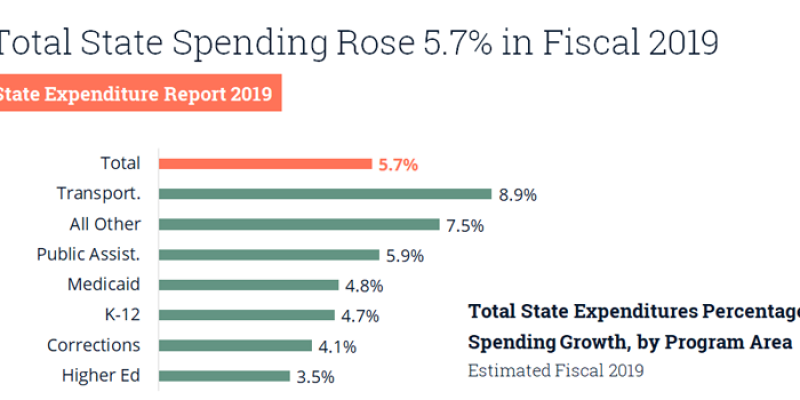State government spending in fiscal 2019 increased at the largest rate since the end of the Great Recession, according to the latest State Expenditure report from the National Association of State Budget Officers (NASBO).
Total state spending reached $2.1 trillion in fiscal 2019, rising from $2 trillion in fiscal 2018. Total state government spending rose 5.7 percent in fiscal 2019. The increased 2019 growth was slightly above the 33-year NASBO survey historical average of 5.6 percent (without adjusting for inflation).
Seven out of eight geographic regions reported an increase in total state spending in fiscal 2019, according to the report. Western states reported the largest increases; Southwestern states saw a slight decline.
Spending from states’ own funds (general funds and other state funds combined, excluding bonds) rose 5.9 percent in fiscal 2019, the highest annual growth rate since the last recession, NASBO found.
Much of the state spending increases were in transportation.
The report breaks down spending by funding source (general funds, other state funds, bonds, and federal funds) and contains information on state general fund and transportation fund revenues. This edition of the report focuses on estimated fiscal 2019, actual fiscal 2018, and actual fiscal 2017.
The report also evaluates state-by-state data in seven program areas: elementary and secondary education, higher education, public assistance, Medicaid, corrections, transportation, and “all other.”
“All other” includes additional spending for pension fund contributions, employee compensation, deposits to reserve funds, debt service, disaster recovery and homelessness programs.
Spending from federal funds to states also rose in fiscal 2019, partly due to recent federal budget agreements, increasing by 4.7 percent compared to 3.5 percent in fiscal 2018.
States reported strong gains in state tax collections in both fiscal 2018 and fiscal 2019, increasing by 6.9 percent in fiscal 2018 and 4.2 percent in fiscal 2019, following two years of slow growth in fiscal 2016 and fiscal 2017.
Transportation spending increased by 8.9 percent with 18 states reporting an increase of at least 10 percent on transportation spending from state funds. Seventeen reported increases of at least 10 percent on “all other” spending from state funds.
“All other” spending increased by 8.6 percent, ranging from additional spending for pension fund contributions, employee compensation, deposits to reserve funds, debt service, disaster recovery, and homelessness programs.
Increased revenue also resulted in revenue surpluses for many states in fiscal years 2018 and 2019. Revenue gains toward the end of the fiscal year contributed to most states ending each fiscal year with a general fund surplus, which many deposited into their rainy day funds, the report says.
State spending growth is expected to slow in fiscal 2020, as states also continue to promote structural balance, long-term sustainability, and strengthening their reserve funds, the report concludes.
This article was first published by The Center Square.
Advertisement
Advertisement

